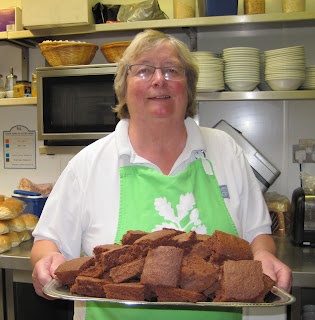Last weekend I had this very opportunity as I was one of a group of 19 who hired the Tower Windmill in Burnham Overy for 3 nights.
Being one of the organisers and the closest, I picked up the enormous
key and chose one of the two bedrooms in the cottage annex, which is also where
the kitchen, pantry, two shower rooms & two toilets are to be found. The
ground floor of the windmill is the main living area with two dormitories each
with four bunk beds and a fourth library floor. With each rise in storey you got
a real sense of the walls leaning in and of course being round.
The kitchen equipment & crockery was put to a real test on the first night as three main courses and side dishes for 19 were cooked, but there was plenty of implements, huge pots & trays helped by two ovens and an army of 10 dishwashers. The second night was simpler by a torchlit stroll to the local pub which served good food at reasonable prices. At no point were we short of anything, least not tea towels and there was space and tables for everyone to be seated together.
The kitchen equipment & crockery was put to a real test on the first night as three main courses and side dishes for 19 were cooked, but there was plenty of implements, huge pots & trays helped by two ovens and an army of 10 dishwashers. The second night was simpler by a torchlit stroll to the local pub which served good food at reasonable prices. At no point were we short of anything, least not tea towels and there was space and tables for everyone to be seated together.
We added bunting & flowers to the main room
The quirky accomodation was only part of our reason for hiring the windmill, another key bit being the opportunity to get outdoors & close to nature on the North Norfolk coast. Our days were filled exploring the area & nature reserves via the numerous paths, bridleways and lanes, on foot, cycle or hopping along the coast on the Coasthopper bus (nearest stop only being half a mile away). We racked up hundreds of miles between us!
My highlights:
- Standing on the balcony drinking ginger wine (thanks Graham) under an orange sky listening to pink-footed geese flying overhead to their roosts
- Amazing views of marshes, dunes, creeks & saltmarsh of Holkham & Scolt Head Island National Nature Reserves
- Fly-by's by barn owls & marsh harriers & the starlings gathering on the sails at dusk
- The hare that ran through the grounds and across the road missing the zooming car
- Being in good company
Top tips:
- Don't read the visitor book on the first night, some groups talk of haunted mirrors & other spooky happenings
- If you're sleeping in a dorm pack eye mask & ear plugs
- Book early via 01263 740241 for an extremely good value break for you, your friends & family


























